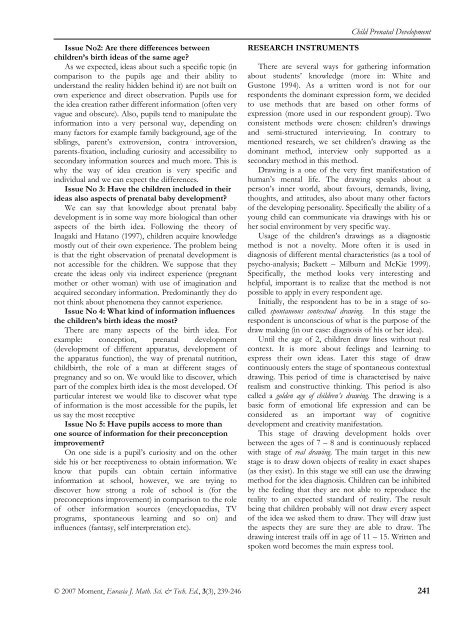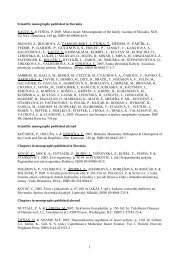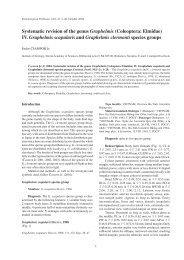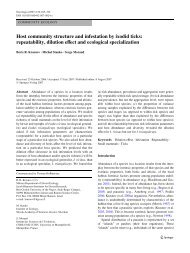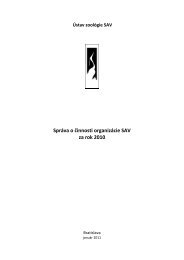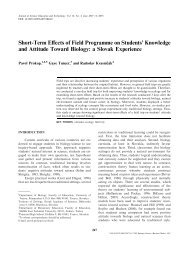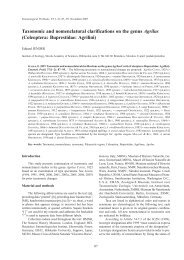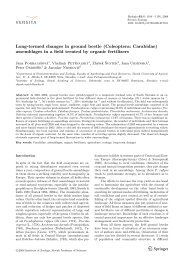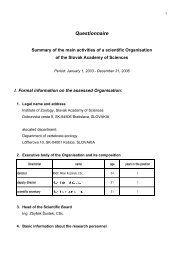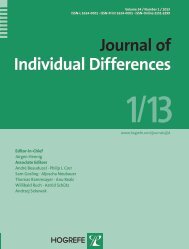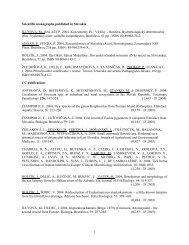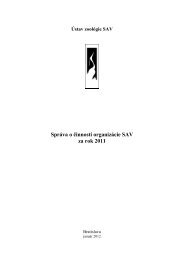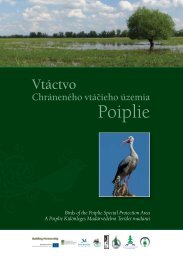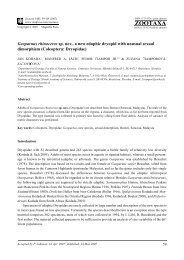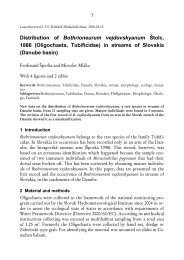Primary Pupils' Preconceptions About Child Prenatal Development
Primary Pupils' Preconceptions About Child Prenatal Development
Primary Pupils' Preconceptions About Child Prenatal Development
Create successful ePaper yourself
Turn your PDF publications into a flip-book with our unique Google optimized e-Paper software.
<strong>Child</strong> <strong>Prenatal</strong> <strong>Development</strong>Issue No2: Are there differences betweenchildren’s birth ideas of the same age?As we expected, ideas about such a specific topic (incomparison to the pupils age and their ability tounderstand the reality hidden behind it) are not built onown experience and direct observation. Pupils use forthe idea creation rather different information (often veryvague and obscure). Also, pupils tend to manipulate theinformation into a very personal way, depending onmany factors for example family background, age of thesiblings, parent’s extroversion, contra introversion,parents-fixation, including curiosity and accessibility tosecondary information sources and much more. This iswhy the way of idea creation is very specific andindividual and we can expect the differences.Issue No 3: Have the children included in theirideas also aspects of prenatal baby development?We can say that knowledge about prenatal babydevelopment is in some way more biological than otheraspects of the birth idea. Following the theory ofInagaki and Hatano (1997), children acquire knowledgemostly out of their own experience. The problem beingis that the right observation of prenatal development isnot accessible for the children. We suppose that theycreate the ideas only via indirect experience (pregnantmother or other woman) with use of imagination andacquired secondary information. Predominantly they donot think about phenomena they cannot experience.Issue No 4: What kind of information influencesthe children’s birth ideas the most?There are many aspects of the birth idea. Forexample: conception, prenatal development(development of different apparatus, development ofthe apparatus function), the way of prenatal nutrition,childbirth, the role of a man at different stages ofpregnancy and so on. We would like to discover, whichpart of the complex birth idea is the most developed. Ofparticular interest we would like to discover what typeof information is the most accessible for the pupils, letus say the most receptiveIssue No 5: Have pupils access to more thanone source of information for their preconceptionimprovement?On one side is a pupil’s curiosity and on the otherside his or her receptiveness to obtain information. Weknow that pupils can obtain certain informativeinformation at school, however, we are trying todiscover how strong a role of school is (for thepreconceptions improvement) in comparison to the roleof other information sources (encyclopaedias, TVprograms, spontaneous learning and so on) andinfluences (fantasy, self interpretation etc).RESEARCH INSTRUMENTSThere are several ways for gathering informationabout students’ knowledge (more in: White andGustone 1994). As a written word is not for ourrespondents the dominant expression form, we decidedto use methods that are based on other forms ofexpression (more used in our respondent group). Twoconsistent methods were chosen: children’s drawingsand semi-structured interviewing. In contrary tomentioned research, we set children’s drawing as thedominant method, interview only supported as asecondary method in this method.Drawing is a one of the very first manifestation ofhuman’s mental life. The drawing speaks about aperson’s inner world, about favours, demands, living,thoughts, and attitudes, also about many other factorsof the developing personality. Specifically the ability of ayoung child can communicate via drawings with his orher social environment by very specific way.Usage of the children’s drawings as a diagnosticmethod is not a novelty. More often it is used indiagnosis of different mental characteristics (as a tool ofpsycho-analysis; Backett – Milburn and McKie 1999).Specifically, the method looks very interesting andhelpful, important is to realize that the method is notpossible to apply in every respondent age.Initially, the respondent has to be in a stage of socalledspontaneous contextual drawing. In this stage therespondent is unconscious of what is the purpose of thedraw making (in our case: diagnosis of his or her idea).Until the age of 2, children draw lines without realcontext. It is more about feelings and learning toexpress their own ideas. Later this stage of drawcontinuously enters the stage of spontaneous contextualdrawing. This period of time is characterised by naiverealism and constructive thinking. This period is alsocalled a golden age of children’s drawing. The drawing is abasic form of emotional life expression and can beconsidered as an important way of cognitivedevelopment and creativity manifestation.This stage of drawing development holds overbetween the ages of 7 – 8 and is continuously replacedwith stage of real drawing. The main target in this newstage is to draw down objects of reality in exact shapes(as they exist). In this stage we still can use the drawingmethod for the idea diagnosis. <strong>Child</strong>ren can be inhibitedby the feeling that they are not able to reproduce thereality to an expected standard of reality. The resultbeing that children probably will not draw every aspectof the idea we asked them to draw. They will draw justthe aspects they are sure they are able to draw. Thedrawing interest trails off in age of 11 – 15. Written andspoken word becomes the main express tool.© 2007 Moment, Eurasia J. Math. Sci. & Tech. Ed., 3(3), 239-246 241


